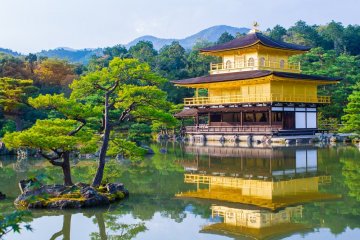
Хиирагия: рёкан в Киото
Bonson LamЭтот роскошный старый вековой рёкан служит пристанищем как для лауреатов Нобелевской премии, так и молодоженам. Спокойный и величественный японский отель - это идеальное место для отдыха вдали от дома.

Known for its academic blessings, Kitano Tenmangu is a Shinto shrine in Kyoto’s Kamigyo ward that is dedicated to Sugawara no Michizane, an influential scholar and politician. The shrine was built in 947 AD and is Japan’s first shrine to enshrine an actual person as a deity. Although there are numerous shrines throughout Japan dedicated to Michizane who is mainly known as a god of academics, Kitano Tenmangu is the original one.
The massive Ro-mon Gate stands as the border between the city and the shrine grounds. This wooden structure, detailed with gold-and-wooden carvings, serves as an introduction to the architectural mastery ahead. Upon entering, it is customary to go to the chozuya and perform a hand-cleansing ritual. After you complete the ritual, explore the shrine’s tranquil grounds.
There are city buses running frequently from Kyoto station to the Kitano Tenman-gu-mae bus stop, which would cost you around ¥230 and will take around 30 minutes.

Этот роскошный старый вековой рёкан служит пристанищем как для лауреатов Нобелевской премии, так и молодоженам. Спокойный и величественный японский отель - это идеальное место для отдыха вдали от дома.

Ужин в рёкане Хиирагия - это праздник души и тела, феерия и торжество японской традиционной кухни!

Комфортабельный отель в центре Киото с индивидуальной спа-ванной и завтраком, включённым в стоимость номера.

Это самый лучший бургер Киото, который вы можете попробовать в уютной обстановке не далеко от императорского дворца.
![Музей лапши "удон" в Киото [Закрыто] Музей лапши "удон" в Киото [Закрыто]](https://a2.cdn.japantravel.com/photo/16830-99298/360x240!/kyoto-the-udon-museum-kyoto-99298.jpg)
Узнайте больше о разновидностях лапши "Удон" в музее удона в Киото

Прочитав множество неистовых отзывов о "Гиндзё рамэн Кубота" в Симогёко в Киото, я решила, что пора и мне попробовать это популярное блюдо, и лучше всего сделать это в аутентичном местном ресторанчике, где подают мисо рамэн.

Well known as the Golden Pavilion, Kinkaku-ji is a three-story Zen Buddhist temple in northern Kyoto. Kinkaku-ji and Ginkaku-ji (Silver Pavilion) were built in the 13th century and were originally intended as noble villas for the Ashikaga shoguns. Today the building is also known as Rokuon-ji. Kinkaku-ji houses several important Buddhist relics and is a sacred place for the Rinzai sect of Japanese Buddhism. Each floor of the temple conveys a different architectural style. The first floor is in the Shinden style, the second floor in the Bukke style and the third floor in the Chinese Zen style. Thus became one of the most photogenic temples in all of Kyoto. The temple was once the retirement villa of the shogun Ashikaga Yoshimitsu. After his death in 1408 he wanted to give the building to the Rinzai sect as a Zen temple. The grounds of the Kinkaku-ji Temple used to consist of several other buildings, but unfortunately burned down in the fires and destruction during the Onin War in the 1400s. The building you see today was also rebuilt in 1955.

Keishunin (桂春院) is one of the sub-temples of Myoshin-ji containing gardens and a teahouse.

Ryoanji Temple is home to Japan’s most famous Zen stone garden and one of Kyoto’s most iconic scenes. Believed to be built back in the Muromachi period (14th - 16th century), the origin and designer of the garden is still unknown to this day. The stones in the garden are intentionally placed so that one cannot view all 15 stones from any one angle. The meticulous design of this karesansui (Japanese rock garden) leads many to credit the celebrated artist, Soami, as the garden’s creator—albeit unproven. The 248-square meter garden bears little trace of greenery, and is instead immaculately lined with raked white gravel. The seemingly random placement of the stones adds to the mystique of Ryoan-ji, its abstract layout leaving visitors questioning the meaning and purpose of the garden. While the garden remains a mystery, the history of Ryoanji Temple is well documented. The temple buildings were originally a Heian Period villa, and were converted into a Zen temple in 1450. Now, Ryoanji is part of the Myoshin-ji school in the Rinzai sect of Zen Buddhism. In 1994, Ryoanji’s immaculate zen stone garden was recognised as a UNESCO World Heritage Site, and is also designated as a Historic Monument of Ancient Kyoto.